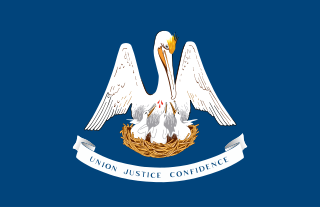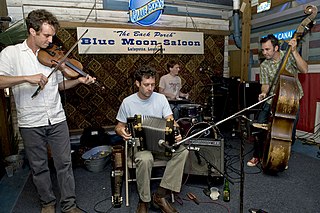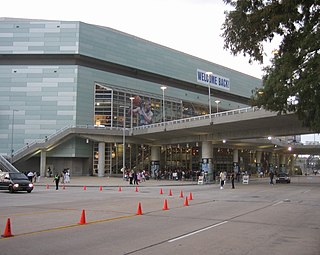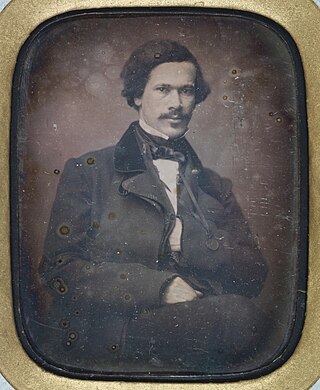
Louisiana is a state in the Deep South and South Central regions of the United States. It borders Texas to the west, Arkansas to the north, and Mississippi to the east. Of the 50 U.S. states, it ranks 20th in land area and the 25th in population, with roughly 4.6 million residents. Reflecting its French heritage, Louisiana is the only U.S. state with political subdivisions termed parishes, which are equivalent to counties, making it one of only two U.S. states not subdivided into counties. Baton Rouge is the state's capital, and New Orleans, a French Louisiana region, is its largest city with a population of about 383,000 people. Louisiana has a coastline with the Gulf of Mexico to the south; a large part of its eastern boundary is demarcated by the Mississippi River.
New Orleans English is American English native to the city of New Orleans and its metropolitan area. Native English speakers of the region actually speak a number of varieties, including the variety most recently brought in and spreading since the 20th century among white communities of the Southern United States in general ; the variety primarily spoken by black residents ; the variety spoken by Cajuns in southern Louisiana ; the variety traditionally spoken by affluent white residents of the city's Uptown and Garden District; and the variety traditionally spoken by lower middle- and working-class white residents of Eastern New Orleans, particularly the Ninth Ward. However, only the last two varieties are unique to New Orleans and are typically those referred to in the academic research as "New Orleans English". These two varieties specific to New Orleans likely developed around the turn of the nineteenth century and most noticeably combine speech features commonly associated with both New York City English and, to a lesser extent, Southern U.S. English. The noticeably New York-like characteristics include the NYC-like short-a split, non-rhoticity, th-stopping, and the recently disappearing coil–curl merger. Noticeably Southern characteristics include the fronting of and possible monophthongization of.

The history of New Orleans, Louisiana traces the city's development from its founding by the French in 1718 through its period of Spanish control, then briefly back to French rule before being acquired by the United States in the Louisiana Purchase in 1803. During the War of 1812, the last major battle was the Battle of New Orleans in 1815. Throughout the 19th century, New Orleans was the largest port in the Southern United States, exporting most of the nation's cotton output and other farm products to Western Europe and New England. As the largest city in the South at the start of the Civil War (1861–1865), it was an early target for capture by Union forces. With its rich and unique cultural and architectural heritage, New Orleans remains a major destination for live music, tourism, conventions, and sporting events and annual Mardi Gras celebrations. After the significant destruction and loss of life resulting from Hurricane Katrina in 2005, the city would bounce back and rebuild in the ensuing years.

Louisiana Creoles are a Louisiana French ethnic group descended from the inhabitants of colonial Louisiana before it became a part of the United States during the period of both French and Spanish rule. They share cultural ties such as the traditional use of the French, Spanish, and Creole languages and predominant practice of Catholicism.

Lost Bayou Ramblers is a Cajun music band from Pilette, Louisiana.

Paul J. Stekler is a political documentary filmmaker, a professor, and former chair and head of the production program in the Department of Radio-Television-Film at the University of Texas at Austin College of Communication. Known for his documentary films about American politics, he was also the on-camera advisor to the cast of The Real World Austin during their attempt to create a documentary about the South by Southwest Music Festival (2005–2006). Among other major filmmaking awards, he has earned two Peabody, three Columbia/duPont, three national Emmy awards, and a Special Jury Award at the Sundance Film Festival.

When the Levees Broke: A Requiem in Four Acts is a 2006 documentary film directed by Spike Lee about the devastation of New Orleans, Louisiana following the failure of the levees during Hurricane Katrina. It was filmed in late August and early September 2005, and premiered at the New Orleans Arena on August 16, 2006 and was first aired on HBO the following week. The television premiere aired in two parts on August 21 and 22, 2006 on HBO. It has been described by Sheila Nevins, chief of HBO's documentary unit, as "one of the most important films HBO has ever made." The title is a reference to the blues tune "When the Levee Breaks" by Kansas Joe McCoy and Memphis Minnie about the Great Mississippi Flood of 1927.

Honduran Americans are Americans of full or partial Honduran descent. Hondurans are the eighth largest Hispanic group in the United States and the third largest Central American population, after Salvadorans and Guatemalans. Hondurans are concentrated in Texas, Florida and California, and are now the largest immigrant group in Louisiana.
The Creoles of color are a historic ethnic group of Louisiana Creoles that developed in the former French and Spanish colonies of Louisiana, Mississippi, Alabama, and Northwestern Florida, in what is now the United States. French colonists in Louisiana first used the term "Creole" to refer to people born in the colony, rather than in Europe, thus drawing a distinction between Old-World Europeans and Africans from their descendants born in the New World. Today, these Creoles of color have assimilated into Black American culture, while some retain their distinct identiy as a subset within the broader African American ethnic group.

Delacroix is an Isleño fishing community and census-designated place (CDP) located in St. Bernard Parish, Louisiana. It was first listed as a CDP in the 2020 census with a population of 48. The community is also popularly known as Delacroix Island. The community was established in 1783 with the settlement of Canary Islanders along Bayou Terre-aux-Boeufs.

Irván J. "Puco" Pérez was an Isleño folk artist and advocate for the Isleño identity. He is most well known for the singing of décimas, but he was also an accomplished woodcarver. Throughout his life, he assisted academics in the study of the Isleño Spanish language, culture, and customs.

Benjamin Franklin High School is a charter high school and a magnet high school in New Orleans, Louisiana. Commonly nicknamed "Franklin" or "Ben Franklin", the school was founded in 1957 as a school for gifted children. Ben Franklin is consistently named the No.1 school in the state of Louisiana and has been ranked by U.S. News & World Report as No. 15 charter school in the nation. In 1990, it moved to its current location on the campus of the University of New Orleans (UNO) in the Lake Terrace/Lake Oaks neighborhood of Orleans Parish, near Lake Pontchartrain. The school was damaged by several feet of flood water due to Hurricane Katrina in the fall of 2005, and efforts to reopen the school were covered by nationwide news agencies. The school is part of the Orleans Parish School Board (OPSB), yet it operates as a charter school and is not administered directly by the agency.
American Tongues is a 1988 sociolinguistic documentary examining American English dialects and accents and perceptions thereof.
Maggie Hadleigh-West is an American filmmaker and activist.
Luis Álvarez or Luis Alvarez may refer to:

Reggio, also known as Bencheque, is an Isleño fishing community located in St. Bernard Parish, Louisiana. The community was established in 1783 with the settlement of Canary Islanders along Bayou Terre-aux-Boeufs. During the last decade of the eighteenth century, Louis de Reggio purchased land from the Isleños to establish a sugarcane plantation. It is perhaps the only community in the United States that bears a Guanche-language name.

Warren Easton Charter High School is a secondary school in New Orleans, Louisiana. The Warren Easton Charter Foundation governs the school, which is chartered by Orleans Parish School Board.

Louis Charles Roudanez (1823-1890) was an American physician and newspaper publisher. He cofounded L'Union (1862-1864), one of the first Black newspapers in the US South and the first bilingual (French-English) newspaper run by African Americans in the United States. After it folded, he cofounded La Tribune de la Nouvelle-Orleans (1864-1870), the nation's first daily Black newspaper, which was also bilingual.
Robert Phillip Kolker is an American film historian, theorist, and critic. He has authored and edited a number of influential books on cinema and media studies. He is a Professor Emeritus at the University of Maryland, College Park.













